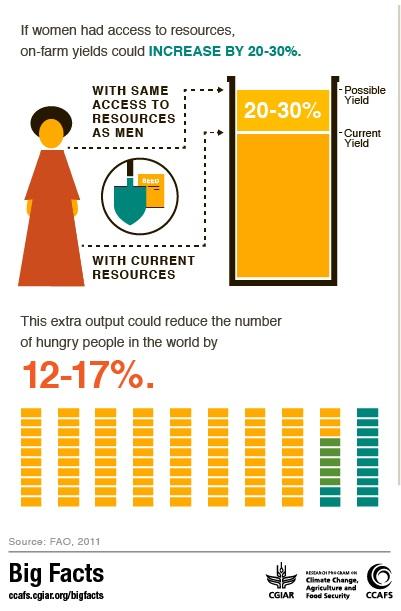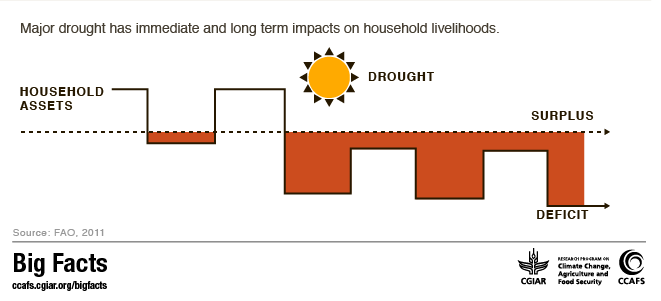Big Facts: Climate impacts on people

This story spotlights some of the Big Facts on climate impacts on people, and is part of a special blog series to complement the new Big Facts infographics website.
Millions of people around the world already struggle to achieve food security and climate change is set to make those challenges even harder. It is perhaps humanity’s most pressing challenge, as we seek to nourish more than nine billion people by 2050.
The impacts of climate change will be numerous, affecting both food supply and demand. Droughts and water scarcity reduce overall food security and diminish dietary diversity. Infectious disease, which shares a vicious circle with malnutrition, will also increase as a result of climate change. Food systems at local levels in small farming communities will also be adversely affected, and overall, climate change could potentially slow down or reverse progress toward a world without hunger.
Poverty and climate change
There is growing recognition that the impacts of climate change and poverty are closely interconnected, as climate change impacts land availability, rainfed agriculture, and the emergence of diseases in the crop, forestry and fishery sectors. Poor people are disproportionately dependent on rainfed agriculture for their livelihoods, and they are thus especially vulnerable to the impacts of climate change.
The increasing frequency and intensity of climatic shocks will decrease poor producers’ abilities to sell an agricultural surplus, meaning less reinvestment in their farms and other livelihood activities, and less ability to buy a nourishing diet. In total, research by Ericksen et al (2011) found that around 265 million people across Latin America, Southern and West Africa, Eastern China, Southeast Asia, and the northern part of south Asia are highly vulnerable to a 5% decrease in the length of the growing season and are likely to face declines in food security due to climate change over the next 40 years.
Gender and climate change
Climate change does not affect men and women equally and might exacerbate gender inequalities with women being disproportionately affected. As women are more dependent on livelihoods and natural resources that are sensitive to climatic changes, they are also more vulnerable to the impacts of climate change. In addition, women represent the majority of the world’s poor and this means they often also lack the means to cope with adverse climate change impacts.
Research highlighted by the United Nations Food and Agriculture Organization (FAO, 2011: 5) show that yields on women’s farms could increase by 20–30% if women had the same access to productive resources as men. This could raise total agricultural output in developing countries by 2.5–4%, which could in turn reduce the number of hungry people in the world by 12–17%.
Read more blogs about gender, agriculture and climate change.
Ecosystem services
While we still don’t know the exact impact which climate change will have on a range of ecosystem services, it is clear that the people that will be the most severely affected are those that depend on well-functioning ecosystem services, such as forests and wetlands, for their livelihood.
The impacts of climate change on ecosystems will not be distributed equally around the world, and special attention needs to be given to marginalized groups, such as subsistence farmers and groups with few means of adaptation.
Vulnerability is often concentrated in lower-income countries or groups, and repeated climate shocks keep people in poverty traps (Carter and Barrett 2006). Given that more than 80% of natural disasters are climate-related – storms, landslides, droughts, floods – and higher-income countries or groups can also be vulnerable to climate extremes, the link between climate change and poverty is clear.
Explore, learn more and participate
To learn more about these challenges, we invite you to explore our infographics and thematic pages. They contain significant amounts of information, and even more is available in the related readings. Should you have any comments or questions, you are welcome to write them below or send us an email. We hope you will enjoy learning about this as much as we enjoyed the research.
Now you can get all the Big Facts on the links between climate change, agriculture and food security at ccafs.cgiar.org/bigfacts2014. The new site features over 100 stunning infographics that illustrate the most up-to-date, thoroughly researched information on these topics.
Big Facts is also an open-access resource. You can download and share the graphics with your friends and colleagues and use them in your presentations and reports. Please do not hesitate to send us any suggestions for improvements, either by commenting below or sending us an email.
This story is part of a series focusing on the Big Facts on various topics and in different regions; join the conversation at ccafs.cgiar.org/blog and on twitter using #bigfacts


